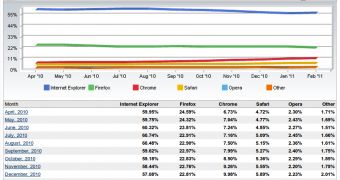In a surprising twist, Internet Explorer gained browser market share in February this while Firefox lost a big chunk and Chrome, uncharacteristically, only gained a modest amount. However, this wasn't due to some strange shift in market trends, rather it was due to new data about internet usage around the world.
New estimates from the CIA meant that Net Applications had to adjust the estimated market share of all of the browsers to account for the shift in the makeup of the world's internet population.
Specifically, 100 million new internet users were added in China, with the updated data, this while the numbers in much of the developed world were much less impressive.
IE saw the only gain in the past six months, due to the adjusted numbers, and now has a total market share of 56.77 percent, up 0.77 percent from the previous month.
Firefox, on the other hand, lost 1.01 percent points in the browser market and now accounts for just 21.74 percent. Chrome did saw a small increase in usage, but a very small one compared to previous months, just a 0.23 percent improvement from January.
Since users in China, India and many of the big emerging markets have a preference for Internet Explorer, the new numbers reflect that. In actuality, it's very unlikely that IE gained any market share in the past month or that Firefox lost so much. This should be evident from the data in the coming months.
"In February, the C.I.A. released new data on how many internet users per country there are. It shows a large increase in the global percentage of Chinese users and a decrease in the global percentage of users from the U.S., U.K, Germany, France and other developed countries," Net Applications wrote.
"These geographic shifts in internet usage have an significant impact on the global usage share numbers starting in February. This adjustment corrects an increasing inaccuracy over time as population shifts occur and reflects reality more closely than unadjusted numbers," it explained.

 14 DAY TRIAL //
14 DAY TRIAL //